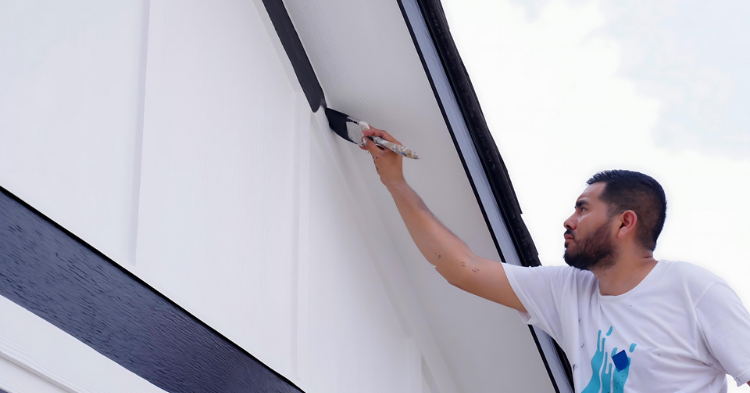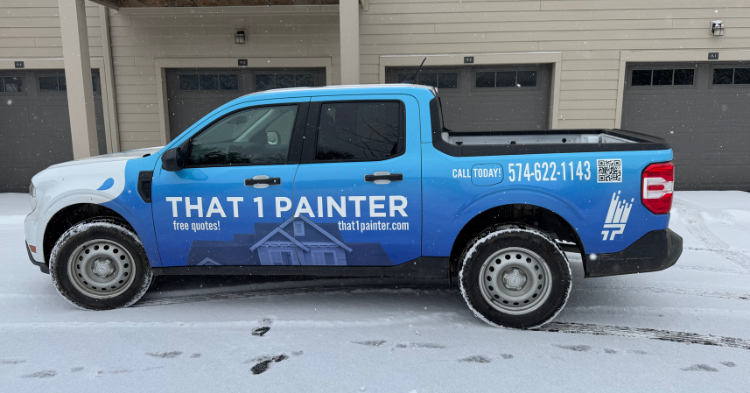What’s the Best Exterior Painting Temperature in Indiana? Tips for Perfect Results
That 1 Painter is the fastest-growing painting company in the world. Painting your space can be complicated, but with our expertise, we make the process easy and stress-free for homeowners. With franchises across the nation, we have helped tens of thousands of homeowners make the best choices for their homes without sacrificing quality, and we are here to show you how.
What’s the Best Exterior Painting Temperature in Indiana? Tips for Perfect Results
When it comes to painting the exterior of your home, the temperature outside can make all the difference! Too hot, and the paint might dry too quickly, leaving you with an uneven finish. Too cold, and your paint might not dry properly, or worse, it could peel or crack. Understanding the best exterior painting temperature in Indiana is key to ensuring a smooth, long-lasting finish.
With Indiana’s unpredictable weather, it’s essential to know how the temperature and humidity affect your exterior paint job. Whether you’re painting your home this spring, summer, fall, or winter, understanding how temperature impacts your painting process can save you time, money, and frustration. Let’s dive into everything you need to know about exterior painting temperatures in Indiana and how to choose the perfect time for your next project!
Why Exterior Painting Temperature Matters in Indiana
When you’re planning to paint the exterior of your home in Indiana, temperature isn’t something to overlook. In fact, it plays a critical role in how your paint adheres, how it cures, and how long it lasts. So, what exactly does temperature affect in your painting process?
The Impact of Temperature on Paint Drying
The drying time of your paint is one of the most important aspects to consider when painting outside. When the temperature is too hot, paint dries too quickly, causing problems like streaking or roller marks. On the flip side, if it’s too cold, the paint may not dry at all, leading to issues with adhesion.
In Indiana, temperatures can vary widely depending on the season. For optimal results, exterior painting should be done when the temperature is between 50°F and 85°F (10°C to 29°C). These temperatures allow the paint to dry slowly and evenly, creating a smooth, flawless finish. If you’re dealing with extreme weather, it’s important to be mindful of the conditions.
Why Indiana’s Climate Can Be Tricky
Indiana is known for its diverse climate, with hot, humid summers and cold winters. This means that the ideal painting temperature will vary depending on the time of year. During the summer, the state experiences high humidity and soaring temperatures, which can affect paint drying times. On the other hand, the winter months bring freezing temperatures that can cause paint to crack, peel, or fail to cure properly.
Risks of Painting in Extreme Temperatures
- Too hot: In summer, when temperatures climb above 90°F (32°C), paint can dry too quickly, leading to an uneven application and visible brush or roller marks.
- Too cold: Winter temperatures below 50°F (10°C) can prevent paint from bonding properly to surfaces, potentially causing cracking, peeling, or fading.

Best Time of Year for Exterior Painting in Indiana
While temperature is a crucial factor, timing also matters when choosing the right moment for exterior painting in Indiana. Let’s look at how different seasons impact your painting schedule.
Spring and Fall: The Ideal Painting Seasons
In Indiana, spring and fall are considered the best times for exterior painting. These seasons typically offer mild temperatures, moderate humidity, and fewer interruptions due to weather. In spring, you’ll avoid the summer heat while benefiting from rising temperatures, which creates a perfect balance for painting. In the fall, the weather is cooler, yet still warm enough to allow proper drying.
These seasons provide a window where temperatures hover between 50°F and 85°F, offering the perfect environment for your exterior paint to adhere, dry, and cure.
Summer Heat: Challenges for Exterior Painting
While summer can be a great time to get outside and tackle projects, it’s not always the best for painting. Temperatures often soar above 90°F (32°C), especially in southern Indiana, causing the paint to dry too quickly. Rapid drying leads to poor adhesion, streaks, and even bubbles in the paint.
If you’re painting during the summer, it’s essential to plan your work during the cooler parts of the day—early mornings or evenings are your best bet. That way, you can avoid the scorching midday heat and let the paint cure without drying too fast.
Winter Cold: Be Cautious with Exterior Painting
Painting during winter in Indiana can be tricky due to freezing temperatures and the chance of snow or rain. In colder months, the temperature can drop below 32°F (0°C), preventing paint from adhering properly to exterior surfaces. Additionally, paint may freeze before it has a chance to cure, which can lead to cracking and peeling once it warms up.
However, there are some special paints formulated for use in cooler temperatures, so if you absolutely need to paint during the winter, be sure to choose the right product. You’ll also need to be extra cautious about conditions, as winter brings unpredictable temperature shifts and adverse weather.
How Temperature Affects Paint Performance and Longevity
Temperature doesn’t just impact the drying time—it also affects the paint’s performance and longevity. If you want your paint job to look great and last for years to come, it’s essential to understand how temperature influences the outcome.
Paint Adhesion and Temperature Sensitivity
One of the most important factors in a successful exterior paint job is adhesion. Paint needs to bond well to the surface to ensure it stays intact and doesn’t peel or flake off. When temperatures are too hot or cold, adhesion can be compromised. High heat can cause the paint to dry too quickly, preventing it from bonding effectively, while cold temperatures slow down the curing process.
Curing Time and Finish Quality
Curing is the final process after paint dries, and it can take anywhere from a few hours to a few days. Temperature plays a critical role in how quickly the paint cures. If you’re painting in temperatures that are too low, the paint may never fully cure, leading to a compromised finish. If it’s too hot, the paint may dry too fast, creating an uneven and streaky finish.
Long-Term Durability
Another thing to consider is the long-term durability of your exterior paint job. Extreme temperatures can cause the paint to fade, crack, or peel more quickly. Paint that cures too quickly in hot weather may not develop the necessary strength to withstand Indiana’s weather, leading to a shorter lifespan.
To ensure that your paint job stands the test of time, it’s important to paint within the recommended temperature range. This helps the paint cure properly and adhere securely, resulting in a durable finish that will last for years.

Weather Challenges to Consider for Exterior Painting in Indiana
While temperature is a major factor in the painting process, other weather conditions—like humidity, rain, and wind—can also have a significant impact. Understanding how to manage these factors can help you achieve the best possible results.
The Role of Humidity
High humidity levels, which are common in Indiana, can cause problems when painting outdoors. During the summer, the humidity can rise significantly, slowing down the drying time and causing the paint to take longer to set. This can result in an uneven application and visible streaks or smudges.
If the air is too humid, you may need to wait for a drier day or use specialized paints that work better in humid conditions. A relative humidity level of 50% or less is ideal for painting.
Rain and Wind
Weather forecasts are your best friend when painting the exterior of your home. Rain can cause paint to drip, run, or not dry properly, especially if you’re painting on porous surfaces like wood or brick. Wind can also be an issue, carrying dust, debris, or dirt onto freshly painted surfaces. If you know that rain or heavy wind is coming, it’s best to postpone your painting project for another day.
How to Paint Safely in Extreme Temperatures
Whether it’s the summer heat or winter chill, there are ways to handle painting jobs during extreme temperatures in Indiana.
Summer Painting Tips
If you need to paint during the hot summer months, here are a few tips to keep in mind:
- Paint early or late: The best time to paint in summer is early in the morning or in the evening when the temperature is lower.
- Use heat-resistant paints: Choose paints specifically designed for hot temperatures. These paints often have additives that help them dry slower and more evenly.
- Protect your surfaces: Use painter’s tape and drop cloths to protect areas from splatters or heat-related damage.
Winter Painting Strategies
Winter painting can be tricky, but it’s not impossible. Here’s what to consider:
- Use cold-weather paints: These paints are designed to cure at lower temperatures and can help ensure your project still looks great.
- Create a controlled environment: If you’re painting in an unheated area, use space heaters to maintain the ideal temperature. Be sure to keep the area well-ventilated.
Choosing the Right Paint for Indiana’s Climate
To make sure your paint job looks fantastic and lasts for years, it’s important to choose the right type of paint. Here’s how you can select the best paint for Indiana’s weather conditions:
Paint Formulations for Different Temperatures
Some paints are better suited for specific temperature ranges. In Indiana, look for paints designed for extreme temperatures, whether it’s hot summer or cold winter. For the summer, consider latex paints with excellent heat resistance, while in winter, oil-based paints might be a better option due to their ability to cure in cooler temperatures.
Using Primer for Extra Protection
Using a primer before applying paint is always a smart move, especially in Indiana’s fluctuating climate. A primer provides an extra layer of protection and ensures better adhesion. Be sure to choose a primer that works well with the type of surface you’re painting and the weather conditions.
Ready to Tackle Your Exterior Painting Project?
At That 1 Painter Michiana, we understand the challenges of painting in Indiana’s unpredictable climate. Our team is equipped to handle whatever hurdle we face. Reach out to our team of professional painters today for a free estimate. Let us be your best house guests ever!